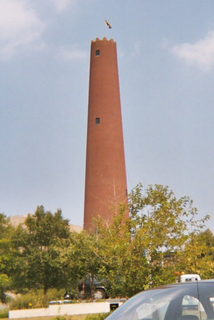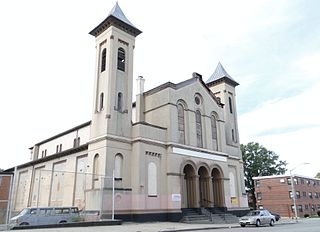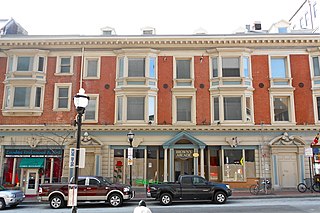
The Phoenix Shot Tower, also known as the Old Baltimore Shot Tower, is a red brick shot tower, 234.25 feet (71.40 m) tall, located near the downtown, Jonestown, and Little Italy communities of East Baltimore, in Maryland. When it was completed in 1828 it was the tallest structure in the United States.

Oakland station is a historic railroad station located at Oakland, Garrett County, Maryland. It is a large brick structure with a two-story central section featuring a cylindrical tower with a domed cap and one-story wings extending from each end along the railroad tracks. It was designed by Baldwin and Pennington, and built in 1884 by the Baltimore and Ohio Railroad across the tracks and a meadow from the Railroad's Oakland Hotel, which opened in 1876, to support the development of Oakland and Garrett County as a resort area. It is one of the finest remaining examples in Maryland of a Queen Anne style railroad station.

Dorchester County Courthouse and Jail is a historic courthouse building located at Cambridge, the county seat of Dorchester County, Maryland. It is an Italianate influenced, painted brick structure, which was enlarged and extensively remodeled with Georgian Revival decorative detailing in the 1930s. The building entrance is flanked on the north by a three-story tower. It was constructed in 1853, and is the only courthouse designed by Richard Upjohn in Maryland.

Towson Academy is a historic National Guard armory building located at Towson, Baltimore County, Maryland. It is a two-story brick structure constructed in 1933 with full basement, faced with a smooth light-colored, marble-like stone veneer. It features a T-shaped plan with a two-story front "head house" section and a one-story perpendicular "drill hall" extending to the rear and its façade is detailed to recall Medieval fortifications, with towers flanking the central entrance.

St. Francis Xavier Church, or Old Bohemia, is a historic Roman Catholic church located at Warwick, Cecil County, Maryland, United States.

Sharp Street Memorial United Methodist Church and Community House is a historic United Methodist church located at Baltimore, Maryland, United States. It is an 1898 Gothic Revival stone structure of massive proportions. It features sharply pitched gables, a square parapeted 85-foot-high bell tower, lancet windows, and Gothic influenced interior decorative detailing. The Community House is a Georgian Revival influenced brick structure, four stories high and built in 1921. The congregation was organized in 1787 and was highly influential in the antebellum freedom movement, the establishment of the first black school in Baltimore after the abolition of slavery, and the movement to foster the institution of the African American Methodist church. It is known as the "Mother Church" of Black Methodism in Maryland. The National Association for the Advancement of Colored People, during their formative years, held their meetings at this historic church.

St. Alphonsus Church, Rectory, Convent and Halle, also known as St. John Neumann Shrine and "Baltimore's Powerhouse of Prayer," is an historic Roman Catholic church complex located within the Archdiocese of Baltimore in Baltimore, Maryland, United States. Since 1992, the parish has held regular Tridentine Masses. It is currently administered by the Priestly Fraternity of Saint Peter.

St. Elizabeth of Hungary is a historic Roman Catholic church complex located within the Archdiocese of Baltimore in the Baltimore-Linwood neighborhood of Baltimore, Maryland, United States.

St. John the Evangelist Roman Catholic Church, now known as Sweet Prospect Baptist Church, is a historic Roman Catholic church located at Baltimore, Maryland, United States.

Public School No. 109, also known as Male and Female Primary School No. 5 and Broadway School, was a historic elementary school located at Baltimore, Maryland, United States. It was a two-story red brick utilitarian building featured a central tower capped by a pediment, two large chimneys with arched openings, and an entrance appendage on the south façade housing a stairwell. It was constructed in 1876 as an "open plan" school with classes separated by glass partitions. It was demolished in late 2003/early 2004 in order to make room for the Kennedy Krieger Institute’s new “Community Behavioral Health Center.”

Public School No. 37, also known as Patrick Henry School and Primary School No. 37, is a historic elementary school located at Baltimore, Maryland, United States. It is an elaborately detailed 2 1⁄2-story Georgian Revival structure. The entrance portico has six freestanding columns, rustication at the base, lintels, and quoins, and a large slate-shingled hip roof. It was built in 1896 for $25,000.

Public School No. 99, also known as Columbus School, is a historic elementary school located at Baltimore, Maryland, United States. It is a two-story Romanesque Revival styled structure constructed in 1891 and expanded in 1905 and 1912. It features a three-story central square tower with pyramidal roof and a flanking pair of cylindrical corner towers with conical roofs. The structure was used as the South Clifton Park Community Center.

Clifton School is a historic elementary school located at Baltimore, Maryland, United States. It is a late 19th-century school with an early 20th-century addition. The structure combines a gable-roofed, "T"-plan, brick county school built in 1882 with a Colonial Revival, flat-roofed, rectangular-plan, brick city school addition built in 1915.

Louisa May Alcott School, also known as "School No. 59" and "Reisterstown Road School," is a historic elementary school located at Baltimore, Maryland, United States. It is a Colonial Revival or Georgian Revival structure completed in 1910. The freestanding building rises 3 ½ to 4 levels from brick base to metal cornice. It features symmetrically designed brick and stucco bands, decorative terra cotta, and three metal cupolas atop the hipped roof.

Public School No. 111, also known as Francis Ellen Harper School, is a historic elementary school located at Baltimore, Maryland, United States. It is a Romanesque brick structure that features an ornately detailed brick front façade. It was built in 1889 as Colored School #9 and is one of the few surviving schools built for black children and staffed by black teachers. The school is named after Francis Ellen Harper (1825-1911), a Baltimore-born African American poet.

Brown's Arcade is a historic retail and office building located at Baltimore, Maryland, United States. It consists of four early 19th century brick rowhouses. Architect Henry F. Brauns redesigned a row of four, three story buildings in 1904 into the original Brown's Arcade, with the application of Colonial Revival details over the original Federal-style façade. It was converted to a series of small shops; bordering a straight central walkway with offices above. The rear courtyard contains two-story brick structures with shed roofs and a two-story Renaissance Revival style structure.

Londontown Manufacturing Company, Inc., also known as Meadow Mill, is a historic cotton mill complex located at Baltimore, Maryland, United States. It is a three-story, Italianate brick structure that features a square tower structure with a truncated spire-like roof having an open bell cupola. It was erected in 1877 as one of five mills which comprised the Woodberry Manufacturing Company. It was intended for the manufacture of seine twines. It was home to London Fog, prior to its move to Eldersburg, Maryland.

Eastern Female High School, also known as Public School No. 116, is a historic female high school located on the southeast corner of the 200 block of North Aisquith Street and Orleans Street, in the old Jonestown / Old Town neighborhoods, east of Downtown Baltimore and now adjacent to the recently redeveloped Pleasant View Gardens housing project / neighborhood of Baltimore, Maryland, United States. It was built in 1869-1870 and is typical of the Italian Villa mode of late 19th-century architecture. It was dedicated in a large ceremony with speeches later published in a printed phamplet and attending crowds in early 1870. Old Eastern High is a two-story brick structure that features a square plan, three corner towers, and elaborate bracketing cornices, with a similar wood decorated porch/portico over front entrance on its west side facing Aisquith Street.

Upton, also known as the David Stewart Residence or Dammann Mansion, is a historic home located at Baltimore, Maryland, United States. It is a large brick Greek Revival mansion constructed about 1838 as the country residence of David Stewart (1800-1858), a prominent Baltimore attorney and politician. It is 2 1/2 stories high on a raised basement, three bays wide and two rooms deep, with a center-passage plan. In the late 1950s, a brick stair tower was constructed when the building was adapted for public school use.

Old Goucher College Buildings is a national historic district in Baltimore, Maryland, United States. It is an approximate 18-block area in the middle of Baltimore which developed in the late 19th and 20th centuries.

























